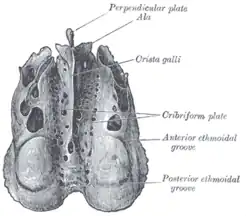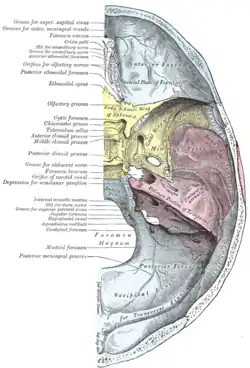Olfactory foramina
The olfactory foramina, also known as the cribriform foramina (cribr- is "a sieve" in Greek), is the grouping of holes located on the cribriform plate. The cribriform plate forms the roof of the nasal cavity, and the olfactory foramina are in the two depressions lateral to the median blade of the cribriform plate called the crista galli. There is a pair of olfactory bulbs of the brain that rest in these two depressions. These holes that make up the olfactory foramina allow passage for about 20 bundles of nerve fibers that make up the olfactory nerve, also known as Cranial Nerve I (CNI), from the nasal cavity to meet with the olfactory bulbs. Therefore, the olfactory foramina are necessary for the human sense of smell.[1][2] These foramina vary in size and number with age.[3]
| Olfactory foramina | |
|---|---|
 Ethmoid bone from above. | |
 Base of the skull. Upper surface. | |
| Details | |
| Identifiers | |
| Latin | foramina cribrosa ossis ethmoidalis |
| TA98 | A02.1.07.003 |
| TA2 | 723 |
| FMA | 75353 |
| Anatomical terminology | |
References
- Saladin, Kenneth S. (2012). Anatomy & Physiology: The Unity of Form and Function. Seventh ed. New York: McGraw-Hill.
- "Olfactory foramen". Farlex Partner Medical Dictionary. 2012. Retrieved Mar 25, 2017.
- Kalmey JK1, Thewissen JG, Dluzen DE (July 1998). "Age-related size reduction of foramina in the cribriform plate". Anat. Rec. 251 (3): 326–9. doi:10.1002/(sici)1097-0185(199807)251:3<326::aid-ar7>3.3.co;2-#. PMID 9669759.
{{cite journal}}: CS1 maint: multiple names: authors list (link)